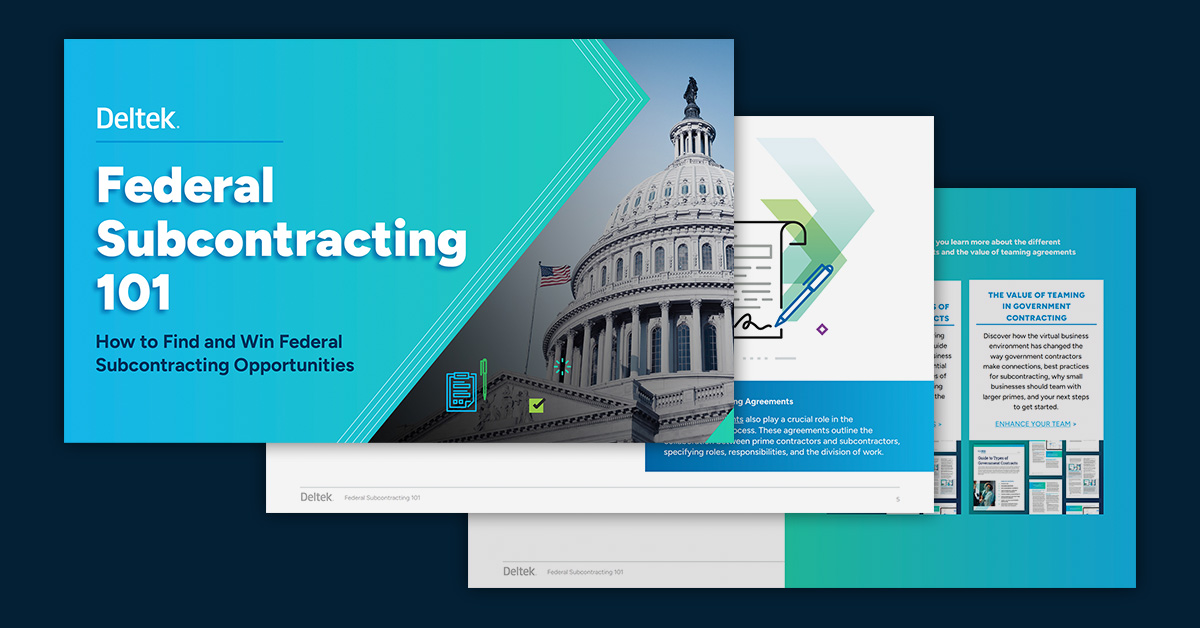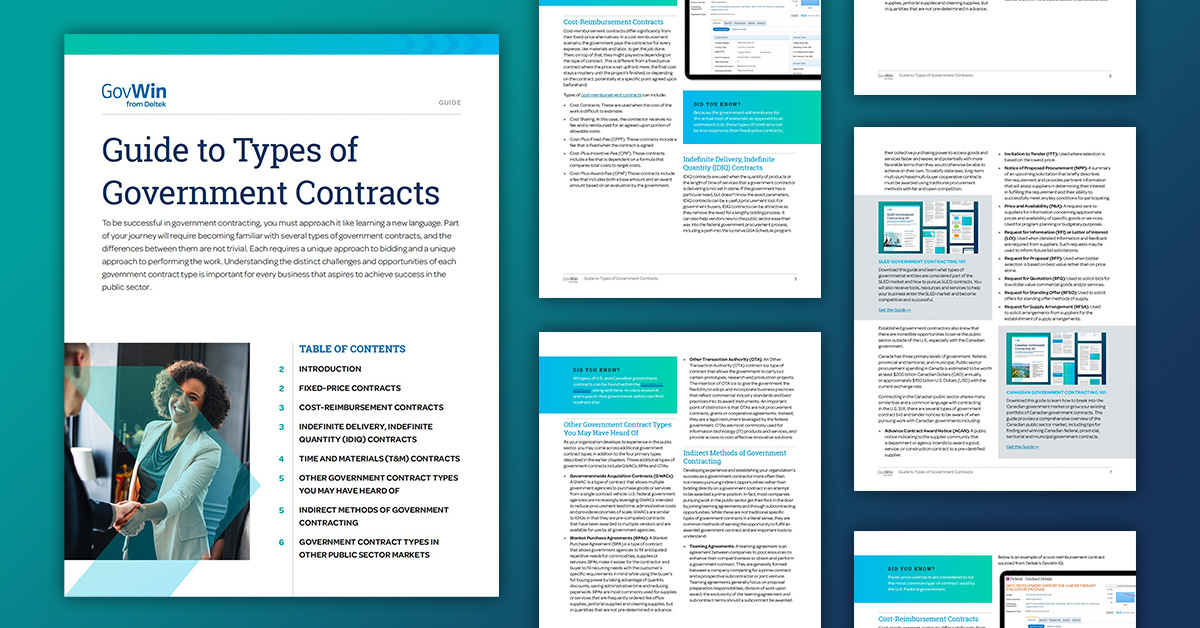Federal Contracting: A Definitive Guide
Why Federal Contracting Matters in 2025
Are you ready to explore federal contracts? Whether you're a small business owner or an established contractor, understanding how federal contracting works—and how it's changing—is crucial in 2025. Federal government contracting remains one of the most stable and lucrative markets, but the landscape is shifting fast.
Before we go into more detail about what federal government contracting is and how to succeed in it, here are some timely resources and practical guidance to help you navigate today’s evolving environment. From new executive orders and shifting agency priorities to a redefined federal budget, staying informed is key to staying competitive:
- Clarity GovCon 2025 Report: Explore the top trends and benchmarks shaping federal contracting this year, and beyond.
- Executive Orders & Policy Blog: Understand how policy changes may impact your government business and gain practical advice to chart a growth path forward.
- FY 2026 Federal Budget Blueprint: See where federal dollars are being allocated to inform your strategy.
- Trump Administration 2025: GovCon Impacts Resource Hub: As policies evolve, contractors must stay informed, maintain contract performance and develop strategic agility. Access free resources to understand the most impactful actions and their implications.
This guide will walk you through the essentials of federal government contracting—from how to find opportunities to strategies for winning and managing contracts
In This Article:
- What is the U.S. Federal Government?
- What are the Executive Agencies and Departments of the Federal Government?
- What is a Federal Government Contractor?
- The Basics of Federal Government Contracting
- Who Puts Out Federal Contract Bids?
- Types of Federal Government Contracts
- Federal Contracting FAQ: How to Find, Win & Succeed in Government Contracts

Free Guide: Federal Contracting 101
Unlock the essentials to winning government business. This quick-start guide shows you how to register, understand contract types, and uncover new federal sales opportunities—so you can compete with confidence.
What is the U.S. Federal Government?
The United States federal government—often referred to as the U.S. federal government—is the national government of the United States, a federal republic located in North America. It governs a union of:
- 50 states
- One federal district (Washington, D.C.)
- Five major self-governing territories (including Puerto Rico and Guam)
- Several island possessions
The federal government operates under the U.S. Constitution and is structured into three distinct branches:
- The Legislative Branch, which creates laws (Congress)
- The Executive Branch, which enforces laws (led by the President)
- The Judicial Branch, which interprets laws (headed by the Supreme Court)
This system of checks and balances ensures that no single branch holds too much power. You can learn more about this structure from USA.gov’s overview of the three branches of government.
Understanding how the federal government is organized is essential for businesses interested in federal contracting, as each agency and department plays a role in procurement, funding, and compliance. For a deeper dive into how the government is structured and how it affects contracting, explore Deltek’s Guide to Government Contracting and GovCon University.
What Are the Executive Agencies and Departments of the Federal Government?
The executive departments of the U.S. federal government are the primary administrative arms of the executive branch, operating under the direct authority of the President. These departments are led by Cabinet-level officials and are responsible for implementing and enforcing federal laws, managing national programs, and overseeing key areas of public policy.
The President’s Cabinet includes the Vice President, the heads of 15 executive departments, and the Attorney General. Each department oversees numerous federal agencies, commissions, and offices that carry out specialized functions—from defense and diplomacy to education and environmental protection.
The 15 Executive Departments Are:
- Department of Agriculture (USDA)
- Department of Commerce (DOC)
- Department of Defense (DoD)
- Department of Education (ED)
- Department of Energy (DOE)
- Department of Health and Human Services (HHS)
- Department of Homeland Security (DHS)
- Department of Housing and Urban Development (HUD)
- Department of the Interior (DOI)
- Department of Justice (DOJ)
- Department of Labor (DOL)
- Department of State (DOS)
- Department of Transportation (DOT)
- Department of the Treasury
- Department of Veterans Affairs (VA)
Active Federal Agency Consolidation and Restructuring
In 2025, significant changes are underway within the federal executive branch. Under the Department of Government Efficiency initiative, commonly referred to as DOGE, several agencies are being consolidated to reduce redundancy and improve service delivery. The most notable transformation is within the Department of Health and Human Services (HHS), which is undergoing a major restructuring:
- 28 divisions are being consolidated into 15, including the creation of a new Administration for a Healthy America (AHA).
- Agencies such as SAMHSA, HRSA, NIOSH, and ATSDR are being merged into AHA to streamline public health services.
- Regional offices are being reduced from 10 to 5.
- The restructuring is expected to reduce the HHS workforce by 10,000 positions, saving an estimated $1.8 billion annually.
These changes may impact how federal contracts are issued, managed, and competed—especially in health-related sectors. Contractors should stay informed about agency realignments, as they may affect procurement processes, points of contact, and funding priorities.
For a deeper understanding of how these changes affect federal contracting and to stay up to date with the late developments, explore Deltek GovWin IQ’s Trump Administration 2.0 Resource Center.

Resource Hub: Build Winning Sales Plans for Top Federal Agencies
Stay ahead of shifting priorities and policy changes. Access free, expert-curated resources packed with market intelligence, agency forecasts, and actionable insights to help you target the right opportunities and build smarter federal sales strategies.
What is a Federal Government Contractor?
A federal government contractor is a private-sector business or organization that provides goods or services to the U.S. federal government through a formal contract. These contracts support a wide range of federal initiatives—from building infrastructure and modernizing IT systems to advancing national defense and public health.
Federal agencies and departments—including the Department of Defense, Department of Transportation, and Department of Homeland Security—regularly issue Requests for Proposals (RFPs) to solicit bids from qualified contractors. These RFPs outline the scope of work, timelines, and evaluation criteria. Businesses respond with proposals, and the most competitive offer is awarded the contract.
To succeed in this space, contractors must understand how to:
- Identify and qualify opportunities
- Navigate federal acquisition process, as outlined by the Federal Acquisition Regulation (FAR)
- Build compliant, compelling proposals
To help you get started—or sharpen your strategy—here are some trusted resources that provide expert guidance and actionable insights:
- Guide to Creating Winning Government Contract Proposals: Learn how to craft proposals that stand out and win
- Top Federal Opportunities: Explore high-value contracts forecasted for this year.
- Acquisition.gov: Visit the official source for federal acquisition regulations and processes.
Understanding what it means to be a federal contractor—and how to position your business for success—is the first step toward capturing new revenue in the government market.

New to Federal Subcontracting?
Start Smart with the Federal Subcontracting 101 Guide. Learn how to break into the federal market by teaming with prime contractors. This free guide walks you through the essentials of finding, qualifying for, and winning subcontracting opportunities.
The Basics of Federal Government Contracting
Federal government contracting—also known as public procurement or government acquisitions—is the process by which U.S. government agencies purchase goods and services from private-sector businesses. These contracts support everything from infrastructure and IT modernization to defense systems and disaster response.
Globally, government procurement accounts for roughly 10–15% of GDP in developed economies, making it a major driver of economic activity. In the United States, the federal government is the largest buyer of goods and services in the world, spending hundreds of billions annually through contracts with businesses of all sizes.
How Federal Contracting Works
In the U.S., federal contracting is governed primarily by the Federal Acquisition Regulation (FAR)—a comprehensive set of rules that standardizes the procurement process across most executive branch agencies. Some agencies, such as the U.S. Postal Service, are exempt from FAR and follow their own acquisition policies.
For defense-related contracts, the Defense Federal Acquisition Regulation Supplement (DFARS) applies in addition to the FAR. This supplement includes specific provisions for working with the Department of Defense (DoD) and its sub-agencies.
Federal contracts may be issued by any of the three branches of government—executive, legislative, or judicial—but the vast majority of procurement activity occurs within the executive branch, particularly through departments like Defense, Homeland Security, Veterans Affairs, and Health and Human Services.

Ready to Compete—and Win—in Federal Contracting?
Get the insights, tools, and strategies you need to succeed in today’s evolving government market. Download your free “Federal Government Contracting 101” guide and start building a smarter path to federal sales.
Who Puts Out Federal Contract Bids?
Federal contract bids are issued by a wide range of U.S. government entities—including the 15 executive departments and the hundreds of agencies, bureaus, and commissions that operate under them. These organizations rely on private-sector contractors to fulfill mission-critical needs across defense, infrastructure, technology, healthcare, and more.
The key government official responsible for issuing and managing these bids is the contracting officer. This individual has the legal authority to bind the federal government to a contract. Each agency has its own contracting officers, and their roles are central to the procurement process.
Where Are Federal Bids Advertised?
Federal agencies use several channels to announce upcoming contract opportunities:
- SAM.gov: The official U.S. government website for contract solicitations and awards
- Socioeconomic set-aside programs: Targeted opportunities for small businesses, women-owned, veteran-owned, and disadvantaged businesses.
- GSA Schedules: Pre-negotiated contracts that streamline procurement for recurring goods and services.
- Industry Days & Forecast Events: Hosted by agencies to preview upcoming solicitations and engage with potential vendors.
- Agency procurement forecasts: Often published annually to outline planned spending.
In 2025, under the Trump Administration’s OneGov strategy, the federal government is taking steps to consolidate more procurement activity under the General Services Administration (GSA). This initiative aims to streamline acquisition, reduce duplication, and leverage governmentwide buying power for better pricing and efficiency.
While these sources are publicly available, navigating them can be time-consuming and fragmented. That’s why many contractors turn to GovWin IQ—Deltek’s market intelligence platform that consolidates public sector opportunities across the United States and Canada into one strategic, searchable solution.
With GovWin IQ, you can:
- Access early visibility into upcoming bids before they’re posted publicly
- Track agency spending trends and procurement forecasts
- Identify teaming partners and competitors
- Discover opportunities across federal, state, local, and Canadian public sector markets.
Types of Federal Government Contracts
Understanding the different types of federal government contracts is essential to building a winning strategy in today’s competitive GovCon landscape. Each contract type comes with unique requirements, risk levels, and pricing structures—making it critical for contractors to align their capabilities and cost models accordingly.
The Four Primary Federal Contract Types
Federal contracts generally fall into four primary categories, each serving distinct procurement needs:
- Fixed-price contracts: These contracts offer a set price for a defined scope of work. They’re ideal when requirements are clear and risk is minimal. Variants include Firm Fixed-Price (FFP), Fixed-Price Incentive (FPI), and Fixed-Price with Economic Price Adjustment (FPEPA). Learn more in our fixed-price contracts guide.
- Cost-reimbursement contracts: Also known as cost-plus contracts, these reimburse contractors for allowable costs and include a fee or incentive. They’re often used in R&D or complex projects where costs are uncertain. Types include Cost-Plus-Fixed-Fee (CPFF) and Cost-Plus-Incentive-Fee (CPIF). Learn more in our cost-reimbursement contracts guide.
- Time and Materials (T&M) Contracts: T&M contracts combine fixed hourly labor rates with reimbursement for materials. They offer flexibility but require close oversight to manage costs and performance. Learn more in our time and materials contracts guide.
- Indefinite Delivery/Indefinite Quantity (IDIQ) Contracts: IDIQs provide flexibility for recurring needs without committing to a fixed quantity upfront. They’re commonly used for IT services, construction, and professional support. Learn more in our IDIQ contracts guide.
Specialized Contract Vehicles and Programs
In addition to the core types, the federal government uses a variety of contract vehicles and set-aside programs to streamline procurement and promote equity:
- GSA Multiple Award Schedules (MAS): These long-term contracts simplify the purchase of commercial products and services. Learn more on the GSA’s Multiple Award Schedule website.
- Governmentwide Acquisition Contracts (GWACs) and Best-in-Class (BIC) Contracts: These pre-vetted vehicles help agencies buy smarter and faster. They’re especially relevant under the Trump Administration’s OneGov procurement consolidation strategy
- Set-Aside Contracts for Small Businesses: Programs like 8(a), HUBZone, Women-Owned Small Business (WOSB), and Service-Disabled Veteran-Owned Small Business (SDVOSB) create exclusive opportunities for eligible firms. Explore Deltek’s Small Business Contracting Guide to learn how to qualify and compete.
- Subcontracting Opportunities: Not ready to prime? Many small businesses start by teaming with established contractors. Subcontracting offers a lower-risk entry point into federal sales and can help build past performance. Explore Deltek’s ‘What is Subcontracting?’ resource page to learn more.
Choosing the Right Federal Contract Strategy
Selecting the right contract type isn’t just about compliance—it’s about positioning your business to deliver value, manage risk, and scale efficiently. Whether you’re pursuing a fixed-price IDIQ or a cost-plus R&D contract, understanding the nuances is key to success.

Free Resource: A Guide to Understanding Types of Government Contracts
Get expert guidance into how each contract type works, when to use them and how to price your bids effectively.
Federal Contracting FAQ: How to Find, Win & Succeed in Government Contracts
Whether you're new to federal contracting or looking to sharpen your competitive edge, these frequently asked questions will help you navigate the path to success in the public sector.
How can I find federal government contract opportunities?
Federal contract opportunities are published on platforms like SAM.gov, GSA eBuy, and agency-specific procurement portals. However, manually tracking these sources can be time-consuming and fragmented.
That’s why many contractors use Deltek GovWin IQ to gain early visibility into upcoming bids, agency forecasts, and competitor activity—all in one place. GovWin IQ helps you:
- Discover opportunities before they’re posted publicly
- Track agency spending trends
- Identify teaming partners and subcontracting leads
Explore GovWin IQ: See how it works >
What’s the best way to win a federal contract?
- Understand the Federal Acquisition Regulation (FAR)
- Build relationships with contracting officers
- Craft compliant, compelling proposals
- Align your pricing and past performance with the agency’s mission
Deltek’s Proposal Management Solutions help streamline the RFP response process, improve collaboration, and increase your win rate.
Free Resource: Guide to Creating Winning Government Proposals >
What tools does Deltek offer to help federal contractors succeed?
Deltek provides an integrated suite of solutions built specifically for the government contracting project lifecycle. Whether you're identifying opportunities, managing costs, or ensuring compliance, Deltek has you covered:
- GovWin IQ: Gain early visibility into U.S. (federal, state, and local) and Canadian government opportunities with the industry’s leading market intelligence platform.
- Costpoint: A purpose-built ERP system that supports compliance, audit readiness, and financial control across the project lifecycle.
- ProPricer: Streamline cost proposal development and pricing analysis to build more competitive, compliant bids.
- TIP Technologies: Ensure quality and compliance in manufacturing and supply chain operations—critical for defense and aerospace contractors.
- Project Portfolio Management (PPM): Optimize project planning, resource allocation, and performance tracking to deliver on time and within budget.
Explore All Solutions: Government Contractor Solutions >
How can small businesses compete for federal contracts?
Small businesses can tap into set-aside programs like 8(a), HUBZone, WOSB, and SDVOSB. These programs reserve contracts for eligible businesses and offer a powerful entry point into the federal market.
Additionally, subcontracting under a prime contractor is a great way to build past performance and gain experience.
Learn More: Selling to the Government as a Small Business Guide >
What are the biggest mistakes to avoid in federal contracting?
Common pitfalls include:
- Failing to register properly in SAM.gov
- Ignoring compliance requirements (e.g., FAR, DFARS, CMMC)
- Underestimating the time and resources needed to respond to RFPs
- Not leveraging market intelligence to shape your pipeline
Avoid these mistakes by investing in the right tools, training, and partnerships. Deltek’s GovCon experts and solutions are designed to help you stay compliant, competitive, and profitable.
Get Started: Download the Federal Contracting 101 Guide →
Related Resources
Guide to Government Contracting
Get the information you need to successfully find win and manage government contracts.Learn More »
How to Find Government Contracts
Get started by finding government contracts that best fit your business.Learn More »
What is DCAA Compliance?
Learn more about DCAA compliance, and how contractors can reduce risk by avoiding and preparing for DCAA audits.Learn More »
Federal Government Contracting
Learn more about federal government contracts and where you can find them.Learn More »
Small Business Contracting
Discover how to find, win and deliver on small business government contracts.Learn More »
Types of Government Contracts
Learn about the four main types of government contracts that contractors encounter.Learn More »
Canadian Government Contracting
Learn more about the Canadian public sector market and how to find Canadian contracts.Learn More »
How to Win Government Contracts
Discover how to beat the competition and win more government contracts.Learn More »
Guide to Govcon Compliance
Learn why compliance should be top of mind for all government contractors.Learn More »
What is CMMC?
Learn more about the basics of Cybersecurity Maturity Model Certification (CMMC).Learn More »
What is ITAR Compliance?
Learn more about the International Traffic in Arms Regulations (ITAR) and who it applies to.Learn More »
State & Local Contracting
Learn the basics of state and local government contracts and where you can find them.Learn More »
Basics of FAR & CAS
Learn about the Federal Acquisition Regulation (FAR) and Cost Accounting Standards (CAS).Learn More »

 Log In
Log In










